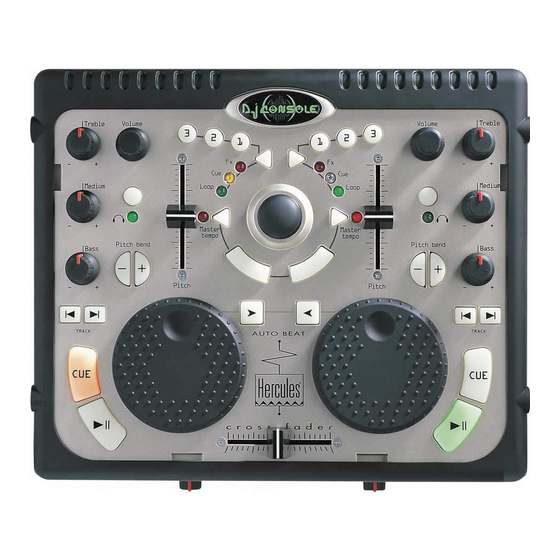
Hercules DJ Console Faqs
Hide thumbs
Also See for DJ Console:
- User manual (16 pages) ,
- Getting started (8 pages) ,
- Using manual (3 pages)
Advertisement
What can I do with Hercules DJ Console?
DJing for beginners starts with performing 3 main operations to animate a party:
1. Starting the music: set a start point (cue point).
Since some tracks start too slowly for dancing, the DJ selects the moment when he or
she wants playback to begin: this is called a cue point (CUE button).
•
The DJ sets the cue point by pressing the CUE button at the right spot in the track,
when the track is not in playback mode, in both Virtual DJ and NewDJ.
•
The DJ can then go straight to the cue point when playing the track:
•
In Virtual DJ, play the track by pressing the Play/Pause button, then press the
CUE button to automatically go to the previously-defined cue point.
•
In NewDJ, press the Play/Pause button and the track automatically starts at the
cue point.
2. Switching from one track to another without disturbing the dancers.
•
Avoid a gap between tracks: use the Crossfader slider.
After loading one track on each deck, when playing both files (press the Play/Pause
buttons) you can switch from one track to the next for the audience by sliding the
Crossfader slider from one deck to the other.
=> Once you are comfortable crossfading, you can DJ at a party. However, there are
other things you can do to make the experience even better.
•
Synchronize the rhythms of 2 tracks: use the AUTO BEAT function.
Your audience will find it easier to switch gradually from one rhythm to another when
they are dancing, rather than be confronted with an instant rhythm change. Whenever
possible, you should synchronize the beat of the track you are playing with that of the
track which will follow it.
•
Calculate the Beats Per Minute (BPM) for each track:
In Virtual DJ: select the audio file, right-click on it with your mouse and select
Analyze. The software then calculates the average BPM for the track.
In NewDJ SE: when listening to music on your headphones, click NewDJ's BPM
Count button on each beat, and NewDJ instantly calculates the track's BPM.
•
Synchronize the BPM of track B with the BPM of track A:
Once you have measured the BPM of the tracks on decks A and deck B, when
you press the AUTO BEAT button on deck B, you change the BPM of deck B to
match the BPM of the track being played on deck A.
You can then use the Crossfader slider to switch from track A to track B, and
dancers won't be bothered since the rhythm of the music won't change. You can
then reset the original BPM on deck B by adjusting the Pitch slider.
=> Once you have synchronized the BPM when switching from one track to another,
dancers can keep the same rhythm when dancing to the new track.
•
Fade the gain levels: use the Bass, Medium and Treble controls.
When switching from one track to another, your mix will sound smoother if you follow
this procedure (there are other ways as well, so this is just a suggestion):
a) When playing track A, set deck A's Bass, Medium and Treble controls between
the mid and max levels, and set deck B's Bass, Medium and Treble controls
between the min and mid levels.
b) When fading from deck A to deck B:
•
Stop the Crossfader at the center for approximately 5 seconds.
•
During this time, boost deck B's Bass, Medium and Treble controls to
between the mid and max levels.
Advertisement
Table of Contents

Summary of Contents for Hercules DJ Console
- Page 1 What can I do with Hercules DJ Console? DJing for beginners starts with performing 3 main operations to animate a party: 1. Starting the music: set a start point (cue point). Since some tracks start too slowly for dancing, the DJ selects the moment when he or she wants playback to begin: this is called a cue point (CUE button).
- Page 2 Connect your microphone to the ¼ inch microphone input plug. • Switch on your microphone. • Turn up the Talkover button on the DJ Console’s front panel to the level you require. • Push the Talkover button (the DJ Console Mixer ON AIR indicator turns red).














Need help?
Do you have a question about the DJ Console and is the answer not in the manual?
Questions and answers